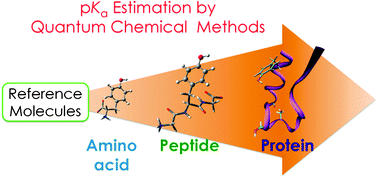We report a scheme for estimating the acid dissociation constant (pKa) based on quantum-chemical calculations combined with a polarizable continuum model, where a parameter is determined for small reference molecules. We calculated the pKa values of variously sized molecules ranging from an amino acid to a protein consisting of 300 atoms. This scheme enabled us to derive a semiquantitative pKa value of specific chemical groups and discuss the influence of the surroundings on the pKa values. As applications, we have derived the pKa value of the side chain of an amino acid and almost reproduced the experimental value. By using our computing schemes, we showed the influence of hydrogen bonds on the pKa values in the case of tripeptides, which decreases the pKa value by 3.0 units for serine in comparison with those of the corresponding monopeptides. Finally, with some assumptions, we derived the pKa values of tyrosines and serines in chignolin and a tryptophan cage. We obtained quite different pKa values of adjacent serines in the tryptophan cage; the pKa value of the OH group of Ser13 exposed to bulk water is 14.69, whereas that of Ser14 not exposed to bulk water is 20.80 because of the internal hydrogen bonds.

You have access to this article
 Please wait while we load your content...
Something went wrong. Try again?
Please wait while we load your content...
Something went wrong. Try again?


 Please wait while we load your content...
Please wait while we load your content...